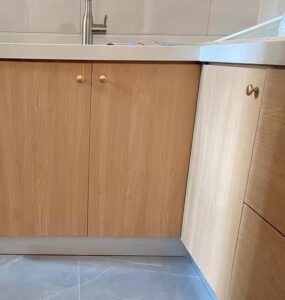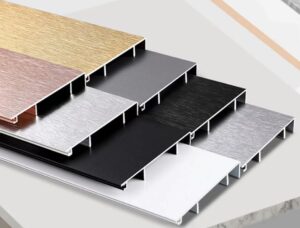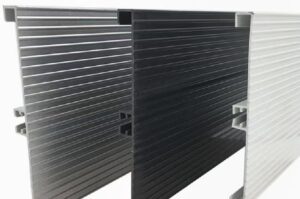The kitchen cabinet toe tick looks insignificant, but it is a part of the decoration that can not be ignored. If the cabinet is less baseboard or the design is unreasonable, it will seriously affect the visual and functional shortcomings of the cabinet decoration, so choosing and following a high-quality and appropriate cabinet baseboard is essential. This issue is for you to explain the cabinet baseboard material and height selection, as well as introduce the cabinet baseboard installation-related knowledge.
What is the kitchen cabinet toe tick?
The Cabinet toe tick, also known as the floor line, is a part of the cabinet, installed at the very bottom of the cabinet, which can stop water and other substances from eroding under the cabinet. The toe kick is the recessed space at the bottom of your base cabinets; a few inches of space that enable your feet to rest comfortably under a small portion of your cabinetry.

The four functions of kitchen cabinet toe tick
1. Toe tick plays a visual balancing role, which can achieve a beautiful effect on the whole cabinet. Their color and linear shape echo with the cabinet, so the entire cabinet can achieve the perfect visual effect.
2. Toe tick plays a protective role because the cabinet kicking line is connected to the ground and the cabinet of excessive components, so that to a large the extent to protect the entire cabinet from external force collision caused by damage, at the same time better make the cabinet and the ground combined firmly.
3. Toe tick plays a waterproof and moisture-proof role, the kitchen is a relatively damp place, with the cabinet kicking line, can effectively prevent the water on the ground to the bottom of the cabinet, to protect the bottom of the cabinet from water erosion, prolonging the service life of the whole set of cabinets.
4.Also can block dust, garbage, mice and cats, and so on.
Three kinds of toe tick
1. Aluminum alloy toe tick Aluminum alloy toe tick, the material is light, will not flood, will not rust, clean ist easy. The corner is connected to the design, to avoid dirty, but also to cover the toe line interface at the sharp stubble, if accidentally kicked will not hurt. The kitchen cabinet uses an aluminum alloy skirting line, which is waterproof and moisture-proof, beautiful and durable, convenient for disassembly and installation, and stable connection.

4.Also can block dust, garbage, mice and cats, and so on.
2. PVC toe tick Waterproof, moisture-proof, no mold, no rust, easy to install, but relatively brittle, used for a long time will be aging, and brittle.

3.Wooden toe tick Wooden skirting line is generally used by manufacturers as the rest of the corner waste when the cabinet body is, the cost is low. However, due to the close distance between the baseboard and the ground, the wooden material is easy to absorb water and becomes damp, and the water vapor will rise along the baseboard and endanger the whole cabinet. This is why some kitchen cabinets become “fat” at the bottom after a period of use.

The toe tick height
market survey data show that the cabinet table height generally will not exceed 100cm, with about 90cm height as the mainstream specifications. In this way, the space left for the cabinet and the cabinet toe tick has been basically positioned, and the sum of the heights of the two will not exceed the above table height, and the cabinet needs to carry a large number of kitchen supplies, especially the floor cabinet, so in terms of height specifications, we try to give large space. Currently, the height specifications of the commonly used floor cabinets are generally around 70-80cm. Of course, according to the customer’s own use of the decision, so that the cabinet is to the height of the specifications of the positioning of the space is about 10cm. 10cm is 100mm specification is it the best height specification of the cabinet toe tick at present? The answer is yes, this scale perfectly matches the proportion of the whole cabinet, giving us a good visual effect, the market sales data is further confirmed this point, at present in the field of cabinet skirting height is mainly based on the specification of 100mm. Of course, there are still some other height specifications, but the commonly used specifications are mainly 100mm and 110mm, which are calculated according to a certain proportion.

